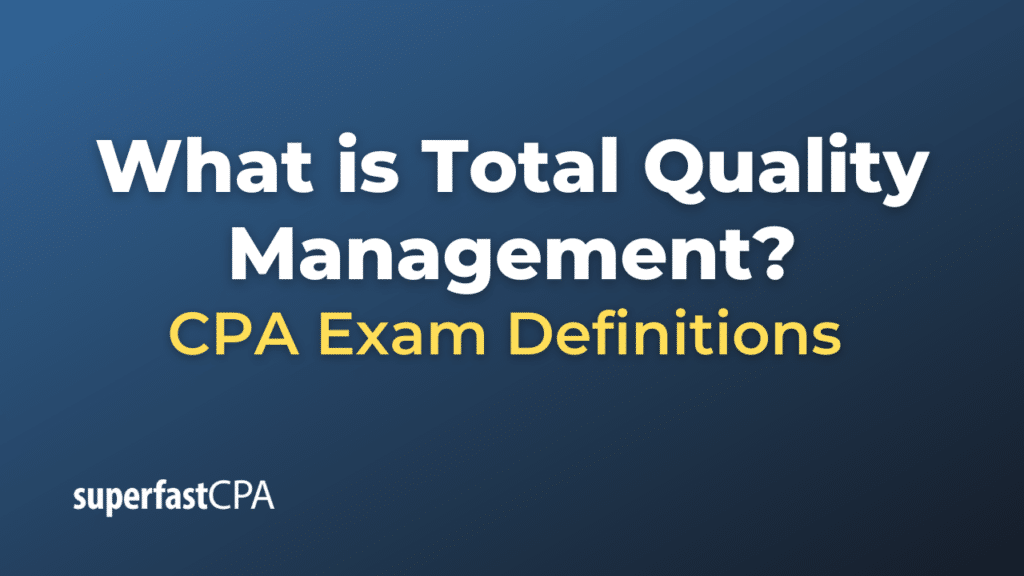Total Quality Management
Total Quality Management (TQM) is a systematic approach to improving the processes, products, and services of an organization by focusing on the continuous enhancement of both the quality of products and services and the means to achieve this improvement. Its primary goal is to enhance customer satisfaction by meeting customer needs and expectations.
TQM involves the participation of all members of an organization, from top-level management to frontline employees, in the process of continuous improvement. It emphasizes a strong customer focus, the involvement and empowerment of employees, and a process-oriented view of business operations.
Key Principles of TQM:
- Customer Focus: Every aspect of an organization’s operations should aim to meet or exceed customer expectations. This requires understanding customer needs and translating these needs into product and service specifications.
- Continuous Improvement: TQM views improvement as a never-ending process. Methods like the Plan-Do-Check-Act (PDCA) cycle are often used to drive and assess improvements.
- Employee Empowerment and Involvement: Employees are seen as vital assets. Their insights, creativity, and dedication play a crucial role in achieving quality improvements. Hence, they are trained, empowered, and involved in decision-making processes.
- Use of Data and Analysis: Decisions are made based on data and analysis rather than intuition. Various tools, including statistical process control, Pareto charts, and cause-and-effect diagrams, are used to measure, analyze, and improve quality.
- Process Approach: TQM focuses on improving processes as the means to improve products and services. If processes are efficient, consistent, and flexible, the end product or service will naturally meet or exceed quality standards.
- Strategic and Systematic Approach: TQM requires a strategic vision, clear objectives, and a systematic approach to embedding quality in the fabric of the organization.
- Effective Communication: Open and transparent communication throughout the organization is essential in promoting understanding, alignment, and commitment to quality goals.
- Leadership and Top Management Commitment: For TQM to be successful, top management must demonstrate its commitment to quality goals and principles, setting the tone and direction for the rest of the organization.
While TQM originated in the manufacturing sector, its principles can be applied across various industries, including services, education, healthcare, and more. Implementing TQM requires cultural transformation, long-term commitment, and a focus on adding value for the customer.
Example of Total Quality Management
Let’s use the example of an imaginary hotel chain, “Prestige Resorts,” to illustrate how Total Quality Management (TQM) might be applied.
Background: “Prestige Resorts” has several properties across the country. While they had a good reputation in the past, recent online reviews indicate a decline in customer satisfaction. Complaints range from unclean rooms to poor food quality and inadequate staff responsiveness.
TQM Implementation:
- Customer Focus:
- The hotel chain initiates a program where guests are encouraged to provide feedback through various platforms – in-house feedback forms, online surveys, and digital kiosks at receptions.
- They set up a dedicated team to review and analyze this feedback to pinpoint exact problem areas.
- Continuous Improvement:
- “Prestige Resorts” starts a pilot project at one of their main properties to address the identified issues. Successes from this project would be rolled out to other properties.
- They use the PDCA cycle to guide this process.
- Employee Empowerment and Involvement:
- The staff at the pilot property is involved in problem-solving teams. Housekeepers, chefs, front desk staff, and even gardeners are consulted about ways to enhance the guest experience.
- Training sessions are organized, including hospitality best practices and soft skills workshops.
- Use of Data and Analysis:
- The team introduces a system to categorize and track customer complaints, making it easier to identify recurring issues.
- They use Pareto charts to prioritize which problems to tackle first.
- Process Approach:
- The team maps out the room cleaning process, identifies inefficiencies and potential points where errors could occur, and then refines the process.
- Similarly, they review and refine processes in the restaurant, from food sourcing to preparation and service.
- Strategic and Systematic Approach:
- The hotel chain’s management sets a clear vision: “To be the most guest-centric hotel chain in the country.”
- They align all improvement initiatives with this vision and set specific, measurable goals.
- Effective Communication:
- Regular town-hall meetings are conducted to keep all staff informed about TQM initiatives, progress, and their roles in the process.
- Feedback from guests, both positive and negative, is shared with relevant departments to reinforce the importance of their roles and celebrate improvements.
- Leadership and Top Management Commitment:
- The CEO of “Prestige Resorts” personally visits the pilot property, interacts with staff, and communicates the importance of the TQM initiative.
- Resources – both financial and human – are allocated to ensure the success of TQM initiatives.
Outcome: After a year, the pilot property sees a significant improvement in guest feedback scores. The number of complaints drops, and positive reviews about cleanliness, food quality, and staff helpfulness increase. The practices and processes refined at the pilot property are then systematically introduced to other properties in the chain.
“Prestige Resorts” not only improves its reputation but also sees financial benefits through repeat bookings and recommendations. The TQM initiative, which began as a strategy to address declining satisfaction scores, becomes a core part of the company’s culture, influencing every decision and action.













